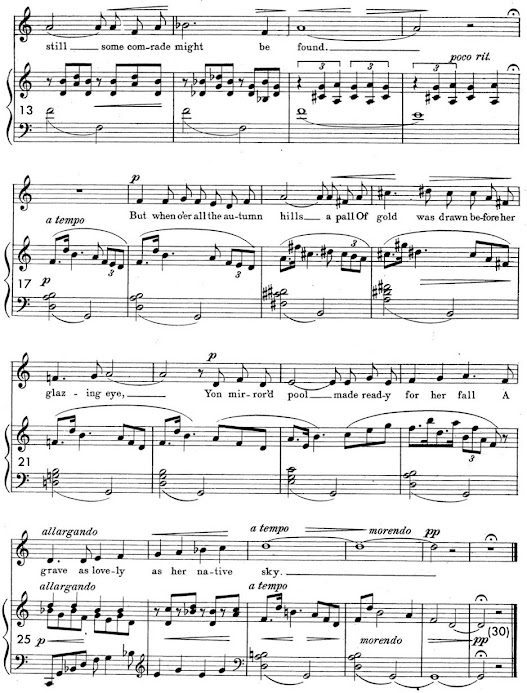Twelve songs by Marion Bauer are readily available through IMSLP. Of those, eight make use of dominant major-ninth harmonies: "The Epitaph of a Butterfly," "Gold of the Day and Night," "Night in the Woods," "Only of Thee and Me," "A Parable," "Roses Breathe in the Night," "Send Me a Dream," and "Thoughts." I am uncertain of composition dates; IMSLP has publication dates of 1912 for "Send Me a Dream," 1914 for "Only of Thee and Me," and 1921 for the others. These correspond to the copyright notices.
The poets are Thomas Walsh (Epitaph), Katharine Adams (Gold; Thoughts), Edward Rowland Sill (Night), Louis Untermeyer (Only), Stephen Crane (Parable), Margaret Widdemer (Roses), and Emilie Francis Bauer (Send).
The first of the eight--"The Epitaph of a Butterfly"--is remarkable in being grounded on a G9 harmony. Treatment of V9 in the others is more typical of American songs in the period after about 1890, both in operettas and musicals and for domestic or recital use.
I'll begin with "The Epitaph of a Butterfly"--see the score below. The poem is a brief narrative of a butterfly in late autumn, falling into a pool to die. The imagery of light and color were an invitation to write in an Impressionist style that reminds me, at least, of Griffes' song "Symphony in Yellow" and perhaps even the opening of "The White Peacock." (Bauer and Griffes were friends, incidentally.)
Here is an annotated version of bars 7-16 (with chord roots added in bars 9-10). The passage begins with a familiar succession of roots in fifths and thirds (G, C, Eb, implied Ab to follow) but with dominant ninth chords. After that is some typical late-19th century chromaticism relying heavily on the ambiguous half-diminished seventh chord. The shift is easily explained by the contrasting texts: "hope" in bars 7-10, followed by a vain search for a "comrade." Finally, note the curiously traditional 2-3 bass suspension at the end (2-3 or 9-10 being the only bass suspension allowed in ancient counterpoint). Also, the V7/ii itself can be explained by separating out the left-hand elements in bar 17--see the end of the example below. The first thing we hear is in fact ii, not V, as iiadd6; only on the third quarter beat is the bass G2 sounded. Although the overall effect here is certainly that of a break, the harmony does offer some continuity.



